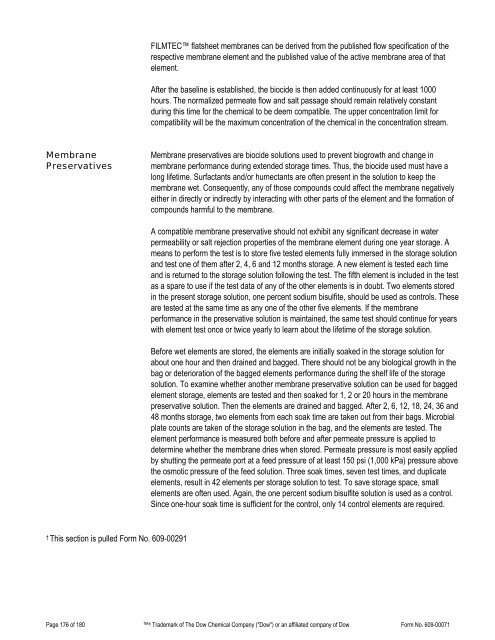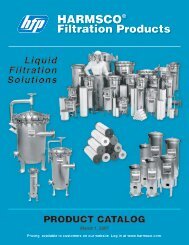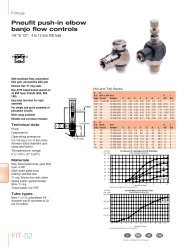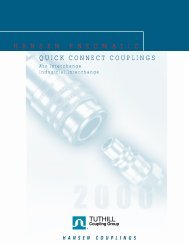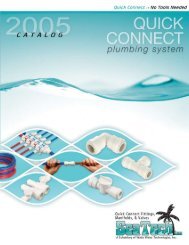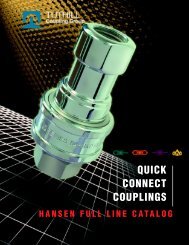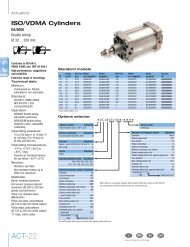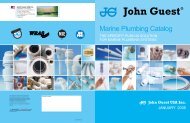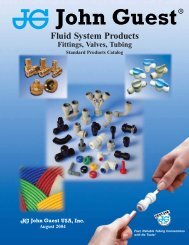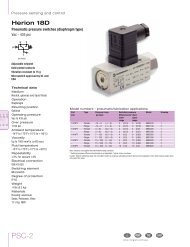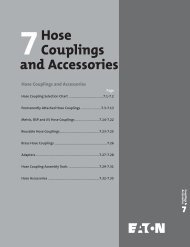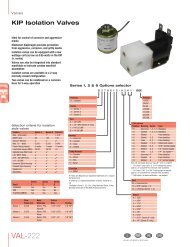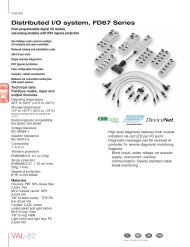FILMTEC flatsheet membranes can be derived from the published flow specification of therespective membrane element and the published value of the active membrane area of thatelement.After the baseline is established, the biocide is then added continuously for at least 1000hours. The normalized permeate flow and salt passage should remain relatively constantduring this time for the chemical to be deem compatible. The upper concentration limit forcompatibility will be the maximum concentration of the chemical in the concentration stream.MembranePreservativesMembrane preservatives are biocide solutions used to prevent biogrowth and change inmembrane performance during extended storage times. Thus, the biocide used must have along lifetime. Surfactants and/or humectants are often present in the solution to keep themembrane wet. Consequently, any of those compounds could affect the membrane negativelyeither in directly or indirectly by interacting with other parts of the element and the formation ofcompounds harmful to the membrane.A compatible membrane preservative should not exhibit any significant decrease in waterpermeability or salt rejection properties of the membrane element during one year storage. Ameans to perform the test is to store five tested elements fully immersed in the storage solutionand test one of them after 2, 4, 6 and 12 months storage. A new element is tested each timeand is returned to the storage solution following the test. The fifth element is included in the testas a spare to use if the test data of any of the other elements is in doubt. Two elements storedin the present storage solution, one percent sodium bisulfite, should be used as controls. Theseare tested at the same time as any one of the other five elements. If the membraneperformance in the preservative solution is maintained, the same test should continue for yearswith element test once or twice yearly to learn about the lifetime of the storage solution.Before wet elements are stored, the elements are initially soaked in the storage solution forabout one hour and then drained and bagged. There should not be any biological growth in thebag or deterioration of the bagged elements performance during the shelf life of the storagesolution. To examine whether another membrane preservative solution can be used for baggedelement storage, elements are tested and then soaked for 1, 2 or 20 hours in the membranepreservative solution. Then the elements are drained and bagged. After 2, 6, 12, 18, 24, 36 and48 months storage, two elements from each soak time are taken out from their bags. Microbialplate counts are taken of the storage solution in the bag, and the elements are tested. Theelement performance is measured both before and after permeate pressure is applied todetermine whether the membrane dries when stored. Permeate pressure is most easily appliedby shutting the permeate port at a feed pressure of at least 150 psi (1,000 kPa) pressure abovethe osmotic pressure of the feed solution. Three soak times, seven test times, and duplicateelements, result in 42 elements per storage solution to test. To save storage space, smallelements are often used. Again, the one percent sodium bisulfite solution is used as a control.Since one-hour soak time is sufficient for the control, only 14 control elements are required.†This section is pulled Form No. 609-00291Page 176 of 180 ® Trademark of The Dow Chemical <strong>Company</strong> ("Dow") or an affiliated company of Dow Form No. 609-00071
9.12 Key Word IndexAbrasion - 150 Burn test - 146 Conductivity meter - 97Acid addition - 27 B-value - 90 Conductivity profile - 140-141Acid cleaner - 126 Continuous process - 75, 76Acridine orange - 59 CAC - 60 Continuous test - 171, 175-177Activated carbon - 59, 62, 64, 65 Calcium - 26-29, 47 Control instruments - 97Adsorption - 65 Calcium carbonate - 27, 28, 32 Copper sulfate - 64Agglomeration - 52 Calcium fluoride - 28, 43 Corrosion - 65, 99, 148Air - 110, 149, 153 Calcium phosphate - 28, 51 Coupler - 106Air break - 98, 112 Calcium sulfate - 40, 42 CRC - 61AISI - 99 Calibration - 138 Crevice corrosion - 99Alarms - 98 Carbon dioxide - 29, 32, 36, 81, 169 Crossflow - 10Al-bronze - 99 Carbonate scaling - 28-29, 32-39, 126, 129, 148Algea - 58 Cartridge filter - 56, 153 DBNPA - 63Alkaline cleaner - 126 Cationic polymers/polyelectrolytes - 28, 52, 150, Dealkalization - 28, 40174Aluminum - 28, 47, 51, 66, 69, 148 Centrifugal pump - 95 Dechlorination - 60Aluminum coagulants - 55, 56 CF - 31, 95 Degasifier - 68Aluminum silicates - 66 CFU - 59 Delamination - 143Ammonium - 55 Check list - 109 Desalination - 9Anoxic - 55, 65, 66, 67 Chemical compatibility - 171-177 Design equations - 90-93Anthracite - 54 Chloramine - 61, 63 Design guidelines - 82-84Antifoulant - 28, 57 Chlorinated biocidal products - 134 Destructive analysis - 144Antiscalant - 28, 33, 56, 58, 66, 154, 173-174 Chlorination - 60 Detergent - 150AOC - 59 Chlorine - 56, 58, 60, 69, 98 Diatomaceous earth - 153Apatite - 51 Chlorine demand - 61 Differential pressure - 54, 57, 58, 123, 146, 152-154Apparent salt passage - 79 Chlorine dioxide - 62, 63, 134 Direct count - 59Application test - 94 Chlorine tolerance - 16, 61, 63 DIRECTOR Service - 142Applications - 11 Clay - 66 Disposal - 136ASTM - 25, 142 Cleaning chemicals - 126, 174-175 Distillation - 9ATP - 60 Cleaning frequency - 82, 139, 174 Dosing pump - 96Automation - 98 Cleaning procedure - 125 Dosing tank - 98Autopsy - 144, 151 Cleaning pump - 125 Double pass - 84, 112A-value - 90 Cleaning solution - 123, 125, 139 Dow sales offices - 181Cleaning system - 124 DOWEX - 28Back-flow - 67, 97 Cleaning tank - 124 Draw-back - 67, 97, 113Backflushable filter - 56 Cleaning test - 142, 144, 175 Dry element - 135, 136Backwash - 54 Clean-in-place (CIP) - 97, 101Bacteria - 58-59 Coagulant - 56, 174 EDXRF - 145, 148Bank filtration - 64 Coagulation-flocculation - 56 Electrodialysis - 10Barium - 28, 29 COD - 69 Element construction - 18Barium sulfate - 42 Colloidal fouling - 52-57, 147 Element outer wrap - 20Barrier layer - 15 Colloidal silica - 47, 56 Element performance - 20, 144Batch process - 75, 84, 97 Combined chlorine - 63 Element removal - 104Beta number - 79 Compaction - 149 Element replacement - 149BFR - 60 Compatibility - 171-177 Element size - 20Biocides - 63, 132, 133, 175-177 Computer program - 90 Element spacer - 81, 106Biofilm - 58, 126, 139, 146 Concentrate recycling/recirculation - 76, 78, 84 Element types - 19, 85Biofiltration - 64 Concentrate valve - 13, 76, 110 Emergency cleaning - 132Biofouling/biological fouling - 21, 58-65, 100, 132, Concentration factor - 31, 95 End cap - 102146, 154Birm - 55 Concentration polarization - 58, 89, 91 Energy consumption - 23Booster pump - 81 Concentration units - 167 Energy recovery - 95Brackish water - 24 Conditioning - 134 Equipment - 102, 107Brine seal - 102, 153-154 Conductance - 164 ESCA - 145Bromide - 61 Conductivity - 81, 112, 116, 165-166 Ethanol - 136Page 177 of 180 ® Trademark of The Dow Chemical <strong>Company</strong> ("Dow") or an affiliated company of Dow Form No. 609-00071
- Page 1 and 2:
DowWater SolutionsFILMTEC Reverse O
- Page 3:
2.6 Biological Fouling Prevention .
- Page 7 and 8:
1. Basics of Reverse Osmosis and Na
- Page 9 and 10:
Nanofiltration (NF)Nanofiltration r
- Page 11 and 12:
How to Use Reverse Osmosis and Nano
- Page 13 and 14:
1.4 Membrane DescriptionThe FILMTEC
- Page 15 and 16:
Membrane systems are typically desi
- Page 17 and 18:
1.8 Element CharacteristicsFILMTEC
- Page 19 and 20:
2. Water Chemistry and Pretreatment
- Page 21 and 22:
SeawaterSeawater with TDS of 35,000
- Page 23 and 24:
Table 2.5 Water analysis for RO/NFS
- Page 25 and 26:
Table 2.7 Solubility products of sp
- Page 27 and 28:
In this process, only Ca 2+ , Ba 2+
- Page 29 and 30:
For the concentration ranges presen
- Page 31 and 32:
The conditions for CaCO 3 scale con
- Page 33 and 34:
Figure 2.3 Langelier saturation ind
- Page 35 and 36:
These computations have been descri
- Page 37 and 38:
Figure 2.5 “K” versus ionic str
- Page 39 and 40:
Figure 2.6 Ksp for CaSO 4 versus io
- Page 41 and 42:
2.4.6 Calcium Fluoride Scale Preven
- Page 43 and 44:
Figure 2.8 K sp for SrSO 4 versus i
- Page 45 and 46:
2.4.7 Silica Scale PreventionDissol
- Page 47 and 48:
Table 2.10 Solubility of SiO 2 vers
- Page 49 and 50:
2.4.8 Calcium Phosphate Scale Preve
- Page 51 and 52:
Table 2.9 Various fouling indicesIn
- Page 53 and 54:
Frequent shutdowns and start-ups sh
- Page 55 and 56:
If the differential pressure across
- Page 57 and 58:
1. Intake (surface) or well, before
- Page 59 and 60:
or combined residual chlorine (CRC)
- Page 61 and 62:
2.6.5 DBNPADBNPA (2,2, dibromo-3-ni
- Page 63 and 64:
2.6.11 Use of Fouling Resistant Mem
- Page 65 and 66:
2.11 Treatment of Feedwater Contain
- Page 67 and 68:
2.13 Summary of Pretreatment Option
- Page 69 and 70:
26. Handbook of Industrial Membrane
- Page 71 and 72:
Table 3.1 System design information
- Page 73 and 74:
3.2 Batch vs. Continuous ProcessAn
- Page 75 and 76:
3.4 Single-Stage SystemIn a single-
- Page 77 and 78:
The apparent salt passage of the sy
- Page 79 and 80:
Instead of having a separate high-p
- Page 81 and 82:
3.9.1 Membrane System Design Guidel
- Page 83 and 84:
In Table 3.6, the small commercial
- Page 85 and 86:
Table 3.8 Number of stages of a sea
- Page 87 and 88:
3.11 System Performance Projection3
- Page 89 and 90:
3.11.2 Design Equations and Paramet
- Page 91 and 92:
Table 3.10 Design equations for pro
- Page 93 and 94:
3.11.3 Comparing Actual Performance
- Page 95 and 96:
The high-pressure concentrate is fe
- Page 97 and 98:
If the product water from an RO sys
- Page 99 and 100:
Besides the above recommendations,
- Page 101 and 102:
4. Loading of Pressure VesselsThis
- Page 103 and 104:
The process of shimming is performe
- Page 105 and 106:
4.5.2 Summary of Large Element Inte
- Page 107 and 108:
5. System Operation5.1 Introduction
- Page 109 and 110:
5.2.3 Start-Up SequenceProper start
- Page 111 and 112:
5.2.4 Membrane Start-Up Performance
- Page 113 and 114:
5.5.3 SeawaterIn principle, the ope
- Page 115 and 116:
Table 5.1 Reverse osmosis operating
- Page 117 and 118:
A. Normalized Permeate FlowQS=ΔPsP
- Page 119 and 120:
For the operating conditions we hav
- Page 121 and 122:
4. During recirculation of cleaning
- Page 123 and 124:
2. The cleaning pump should be size
- Page 125 and 126: 6.7 Effect of pH on Foulant Removal
- Page 127 and 128: Cleaning ProcedureThere are seven s
- Page 129 and 130: If the organic fouling is the resul
- Page 131 and 132: There are two factors that greatly
- Page 133 and 134: 7. Handling, Preservation and Stora
- Page 135 and 136: 7.4 Preservation of RO and NF Syste
- Page 137 and 138: If the normalized actual performanc
- Page 139 and 140: 8.3.3 Localization of High Solute P
- Page 141 and 142: Figure 8.2 Permeate probing apparat
- Page 143 and 144: 8.4.5 Performance TestThe standard
- Page 145 and 146: 8.5.1.1 Low Flow and Normal Solute
- Page 147 and 148: . Metal Oxide FoulingMetal oxide fo
- Page 149 and 150: . Organic FoulingThe adsorption of
- Page 151 and 152: 8.5.3 High Pressure DropHigh differ
- Page 153 and 154: In case of fullfit or heat sanitiza
- Page 155 and 156: Breakpoint chlorinationBreak tankBr
- Page 157 and 158: FeedThe input solution to a treatme
- Page 159 and 160: Milligram per litre (mg/L)Mixed-bed
- Page 161 and 162: SBS Sodium bisulfite, NaHSO 3.Scale
- Page 163 and 164: 9.2 Specific Conductance of Sodium
- Page 165 and 166: Figure 9.1 Conductivity of ionic so
- Page 167 and 168: 9.6 Temperature Correction FactorTa
- Page 169 and 170: 9.9 Osmotic Pressure of Sodium Chlo
- Page 171 and 172: Details - TestEquipment andSpecific
- Page 173 and 174: satisfactory for such a determinati
- Page 175: case for almost all tested biocides
- Page 179 and 180: Positive displacement pump - 95 Shu


